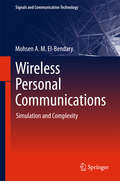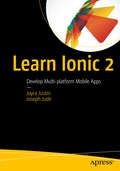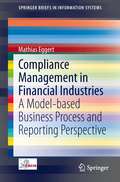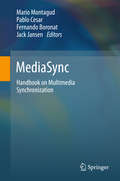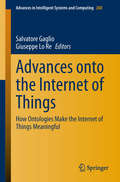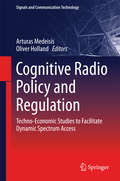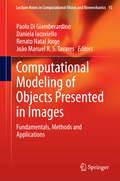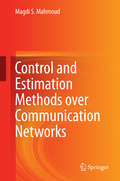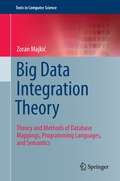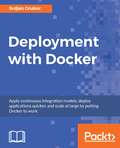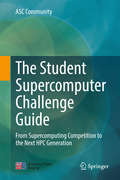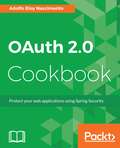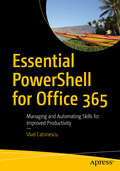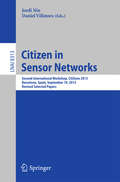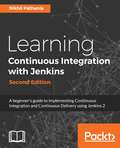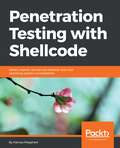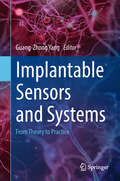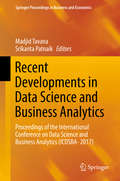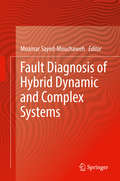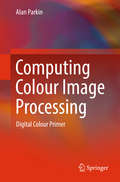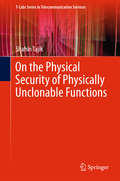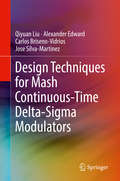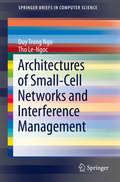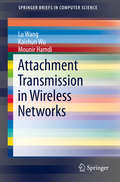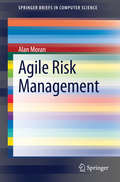- Table View
- List View
Wireless Personal Communications: Simulation And Complexity (Signals And Communication Technology)
by Mohsen A. M. El-BendaryThis book introduces wireless personal communications from the point of view of wireless communication system researchers. Existing sources on wireless communications put more emphasis on simulation and fundamental principles of how to build a study model. In this volume, the aim is to pass on to readers as much knowledge as is essential for completing model building of wireless communications, focusing on wireless personal area networks (WPANs). This book is the first of its kind that gives step-by-step details on how to build the WPANs simulation model. It is most helpful for readers to get a clear picture of the whole wireless simulation model by being presented with many study models. The book is also the first treatise on wireless communication that gives a comprehensive introduction to data-length complexity and the computational complexity of the processed data and the error control schemes. This volume is useful for all academic and technical staff in the fields of telecommunications and wireless communications, as it presents many scenarios for enhancing techniques for weak error control performance and other scenarios for complexity reduction of the wireless data and image transmission. Many examples are given to help readers to understand the material covered in the book. Additional resources such as the MATLAB codes for some of the examples also are presented.
Learn Ionic 2
by Joyce Justin Joseph JudeExplore key scenarios required for building quality Ionic apps quickly and easily and bring them to the iOS and Android mobile ecosystem. Learn Ionic 2 explains various techniques to quickly integrate third-party back end systems. With this short guide, you'll benefit from practical examples of implementing authentication and authorization, connecting to social media, integrating with payment gateway, and analytics integration. This book presents solutions to the challenges faced during the development process of these tasks.Validation is essential to the survival and eventual success of any startup. You validate your business idea by placing a product in the hands of your customers and getting them to interact with it. The Ionic framework makes this possible.What You'll Learn: Master end-to-end hybrid application developmentCreate user management modules including signup, login, and forgotten passwordsUse analytics to evaluate an application using Ionic FrameworkWho This Book Is For: Tech entrepreneurs and businessmen with ideas
Compliance Management in Financial Industries: A Model-based Business Process and Reporting Perspective (SpringerBriefs in Information Systems)
by Mathias EggertSince the peak of the world financial crisis in 2008, compliance management has gained more and more interest from practice and research. In particular the financial service industry is strongly regulated and has to follow specific laws, standards and guidelines. Considering the steadily increasing number of legal requirements in the design of information systems is a challenge to financial service providers. This book investigates the challenges of compliance management in financial industries and provides solutions for a compliant design of information models. From a business process perspective, an approach is presented that enables the automatic checking of business process models. From a supervisory reporting perspective a modeling technique is presented that allows for modeling regulatory data warehouse requirements as well as its analysis. Besides these two perspectives the author provides insights into the perceived relationship of Information Systems and Law.
MediaSync: Handbook On Multimedia Synchronization
by Mario Montagud Pablo Cesar Fernando Boronat Jack JansenThis book provides an approachable overview of the most recent advances in the fascinating field of media synchronization (mediasync), gathering contributions from the most representative and influential experts. Understanding the challenges of this field in the current multi-sensory, multi-device, and multi-protocol world is not an easy task. The book revisits the foundations of mediasync, including theoretical frameworks and models, highlights ongoing research efforts, like hybrid broadband broadcast (HBB) delivery and users’ perception modeling (i.e., Quality of Experience or QoE), and paves the way for the future (e.g., towards the deployment of multi-sensory and ultra-realistic experiences). Although many advances around mediasync have been devised and deployed, this area of research is getting renewed attention to overcome remaining challenges in the next-generation (heterogeneous and ubiquitous) media ecosystem. Given the significant advances in this research area, its current relevance and the multiple disciplines it involves, the availability of a reference book on mediasync becomes necessary. This book fills the gap in this context. In particular, it addresses key aspects and reviews the most relevant contributions within the mediasync research space, from different perspectives. Mediasync: Handbook on Multimedia Synchronization is the perfect companion for scholars and practitioners that want to acquire strong knowledge about this research area, and also approach the challenges behind ensuring the best mediated experiences, by providing the adequate synchronization between the media elements that constitute these experiences.
Advances onto the Internet of Things: How Ontologies Make the Internet of Things Meaningful (Advances in Intelligent Systems and Computing #260)
by Giuseppe Lo Re Salvatore GaglioThe title of this book is a pun on the use of the preposition "onto" with the aim of recalling "Ontology", the term commonly adopted in the computer science community to indicate the study of the formal specification for organizing knowledge. In the field of knowledge engineering, Ontologies are used for modeling concepts and relationships on some domain. The year 2013 celebrates the twentieth anniversary of the World Wide Web. The simple network of hypermedia has transformed the world of communications with enormous implications on the social relationships. However, traditional World Wide Web is currently experiencing a challenging evolution toward the Internet of Things (IoT), today feasible thanks to the integration of pervasive technologies capable of sensing the environment. The most important contribution of IoT regards the possibility of enabling more efficient machine-to-machine cooperation. To such aim, ontologies represent the most suitable tool to enable transfer and comprehension of information among computer applications, even those designed and developed by unrelated people in different places. This book proposes a collection of contributions illustrating different applications following these directions and that are the outcomes of real experiences developed in the context of research projects.
Cognitive Radio Policy and Regulation: Techno-Economic Studies to Facilitate Dynamic Spectrum Access (Signals and Communication Technology)
by Arturas Medeisis Oliver HollandThis book offers a timely reflection on how the proliferation of advanced wireless communications technologies, particularly cognitive radio (CR) can be enabled by thoroughly-considered policy and appropriate regulation. It looks at the prospects of CR from the divergent standpoints of technological development and economic market reality. The book provides a broad survey of various techno-economic and policy aspects of CR development and provides the reader with an understanding of the complexities involved as well as a toolbox of possible solutions to enable the evolutionary leap towards successful implementation of disruptive CR technology or indeed any other novel wireless technologies. Cognitive Radio Policy and Regulation showcases the original ideas and concepts introduced into the field of CR and dynamic spectrum access policy over nearly four years of work within COST Action IC0905 TERRA, a think-tank with participants from more than 20 countries. The book's subject matter includes: * deployment scenarios for CR; * technical approaches for improved spectrum sharing; * economic aspects of CR policy and regulation; * impact assessment of cognitive and software-defined radio; and * novel approaches to spectrum policy and regulation for the age of CR. The book will interest researchers in the field of wireless communications, especially those working with standardization and policy issues, as well as industry and regulatory professionals concerned with radio spectrum management and the general development of wireless communications. Considerable complementary reference material such as power point slides and technical reports that illustrates and expands on the contents of the book is provided on the companion website to the book, found at http://www. cost-terra. org/CR-policy-book
Computational Modeling of Objects Presented in Images: Fundamentals, Methods and Applications (Lecture Notes in Computational Vision and Biomechanics #15)
by João Manuel R. S. Tavares Daniela Iacoviello Paolo Giamberardino Renato Natal JorgeThis book contains extended versions of selected papers from the 3rd edition of the International Symposium CompIMAGE. These contributions include cover methods of signal and image processing and analysis to tackle problems found in medicine, material science, surveillance, biometric, robotics, defence, satellite data, traffic analysis and architecture, image segmentation, 2D and 3D reconstruction, data acquisition, interpolation and registration, data visualization, motion and deformation analysis and 3D vision.
Control and Estimation Methods over Communication Networks
by Magdi S. MahmoudThis book provides a rigorous framework in which to study problems in the analysis, stability and design of networked control systems. Four dominant sources of difficulty are considered: packet dropouts, communication bandwidth constraints, parametric uncertainty, and time delays. Past methods and results are reviewed from a contemporary perspective, present trends are examined, and future possibilities proposed. Emphasis is placed on robust and reliable design methods. New control strategies for improving the efficiency of sensor data processing and reducing associated time delay are presented. The coverage provided features: · an overall assessment of recent and current fault-tolerant control algorithms; · treatment of several issues arising at the junction of control and communications; · key concepts followed by their proofs and efficient computational methods for their implementation; and · simulation examples (including TrueTime simulations) to provide hands-on experience. In addition to the theoretical coverage, the author describes a number of applications that demonstrate the real-world relevance of this material, and these include: · a servo system; · a triple inverted pendulum; · power system control; · wireless control of a cart with inverted pendulum and wireless servo application with emphasis on controller area networks; and · switched ethernet and wireless area networks. Researchers and graduate students working in networked and distributed control will find this text a useful guide in avoiding and ameliorating common and serious problems with these systems. The increasing prevalence of networks in many fields of engineering will make Control and Estimation Methods over Communication Networks of interest to practitioners with backgrounds in communications, process engineering, robotics, power, automotive and other areas.
Big Data Integration Theory: Theory and Methods of Database Mappings, Programming Languages, and Semantics (Texts in Computer Science)
by Zoran MajkićThis book presents a novel approach to database concepts, describing a categorical logic for database schema mapping based on views, within a framework for database integration/exchange and peer-to-peer. Database mappings, database programming languages, and denotational and operational semantics are discussed in depth. An analysis method is also developed that combines techniques from second order logic, data modeling, co-algebras and functorial categorial semantics. Features: provides an introduction to logics, co-algebras, databases, schema mappings and category theory; describes the core concepts of big data integration theory, with examples; examines the properties of the DB category; defines the categorial RDB machine; presents full operational semantics for database mappings; discusses matching and merging operators for databases, universal algebra considerations and algebraic lattices of the databases; explores the relationship of the database weak monoidal topos w. r. t. intuitionistic logic.
Deployment with Docker
by Srdjan GruborA practical guide to rapidly and efficiently mastering Docker containers, along with tips and tricks learned in the field. About This Book • Use Docker containers, horizontal node scaling, modern orchestration tools (Docker Swarm, Kubernetes, and Mesos) and Continuous Integration/Continuous Delivery to manage your infrastructure. • Increase service density by turning often-idle machines into hosts for numerous Docker services. • Learn what it takes to build a true container infrastructure that is scalable, reliable, and resilient in the face of increased complexities from using container infrastructures. • Find out how to identify, debug, and mitigate most real-world, undocumented issues when deploying your own Docker infrastructure. • Learn tips and tricks of the trade from existing Docker infrastructures running in production environments. Who This Book Is For This book is aimed at system administrators, developers, DevOps engineers, and software engineers who want to get concrete, hands-on experience deploying multi-tier web applications and containerized microservices using Docker. This book is also for anyone who has worked on deploying services in some fashion and wants to take their small-scale setups to the next level (or simply to learn more about the process). What You Will Learn • Set up a working development environment and create a simple web service to demonstrate the basics • Learn how to make your service more usable by adding a database and an app server to process logic • Add resilience to your services by learning how to horizontally scale with a few containers on a single node • Master layering isolation and messaging to simplify and harden the connectivity between containers • Learn about numerous issues encountered at scale and their workarounds, from the kernel up to code versioning • Automate the most important parts of your infrastructure with continuous integration In Detail Deploying Docker into production is considered to be one of the major pain points in developing large-scale infrastructures, and the documentation available online leaves a lot to be desired. With this book, you will learn everything you wanted to know to effectively scale your deployments globally and build a resilient, scalable, and containerized cloud platform for your own use. The book starts by introducing you to the containerization ecosystem with some concrete and easy-to-digest examples; after that, you will delve into examples of launching multiple instances of the same container. From there, you will cover orchestration, multi-node setups, volumes, and almost every relevant component of this new approach to deploying services. Using intertwined approaches, the book will cover battle-tested tooling, or issues likely to be encountered in real-world scenarios, in detail. You will also learn about the other supporting components required for a true PaaS deployment and discover common options to tie the whole infrastructure together. At the end of the book, you learn to build a small, but functional, PaaS (to appreciate the power of the containerized service approach) and continue to explore real-world approaches to implementing even larger global-scale services. Style and approach This in-depth learning guide shows you how to deploy your applications in production using Docker (from the basic steps to advanced concepts) and how to overcome challenges in Docker-based infrastructures. The book also covers practical use-cases in real-world examples, and provides tips and tricks on the various topics.
The Student Supercomputer Challenge Guide
by Asc CommunityThis guide provides a comprehensive overview of High Performance Computing (HPC) to equip students with a full skill set including cluster setup, network selection, and a background of supercomputing competitions. It covers the system, architecture, evaluating approaches, and other practical supercomputing techniques. As the world’s largest supercomputing hackathon, the ASC Student Supercomputer Challenge has attracted a growing number of new talent to supercomputing and has greatly promoted communications in the global HPC community. Enclosed in this book, readers will also find how to analyze and optimize supercomputing systems and applications in real science and engineering cases.
OAuth 2.0 Cookbook
by Adolfo Eloy NascimentoEfficiently integrate OAuth 2.0 to protect your mobile, desktop, Cloud applications and APIs using Spring Security technologies. About This Book • Interact with public OAuth 2.0 protected APIs such as Facebook, LinkedIn and Google. • Use Spring Security and Spring Security OAuth2 to implement your own OAuth 2.0 provider • Learn how to implement OAuth 2.0 native mobile clients for Android applications Who This Book Is For This book targets software engineers and security experts who are looking to develop their skills in API security and OAuth 2.0. Prior programming knowledge and a basic understanding of developing web applications are necessary. As this book's recipes mostly use Spring Security and Spring Security OAuth2, some prior experience with Spring Framework will be helpful. What You Will Learn • Use Redis and relational databases to store issued access tokens and refresh tokens • Access resources protected by the OAuth2 Provider using Spring Security • Implement a web application that dynamically registers itself to the Authorization Server • Improve the safety of your mobile client using dynamic client registration • Protect your Android client with Proof Key for Code Exchange • Protect the Authorization Server from invalid redirection In Detail OAuth 2.0 is a standard protocol for authorization and focuses on client development simplicity while providing specific authorization flows for web applications, desktop applications, mobile phones, and so on. This book also provides useful recipes for solving real-life problems using Spring Security and creating Android applications. The book starts by presenting you how to interact with some public OAuth 2.0 protected APIs such as Facebook, LinkedIn and Google. You will also be able to implement your own OAuth 2.0 provider with Spring Security OAuth2. Next, the book will cover practical scenarios regarding some important OAuth 2.0 profiles such as Dynamic Client Registration, Token Introspection and how to revoke issued access tokens. You will then be introduced to the usage of JWT, OpenID Connect, and how to safely implement native mobile OAuth 2.0 Clients. By the end of this book, you will be able to ensure that both the server and client are protected against common vulnerabilities. Style and approach With the help of real-world examples, this book provides step by step recipes for troubleshooting and extending your API security. The book also helps you with accessing and securing data on mobile, desktop, and cloud apps with OAuth 2.0.
Essential PowerShell for Office 365: Managing And Automating Skills For Improved Productivity
by Vlad CatrinescuTake your Office 365 skills to the next level. Master PowerShell for Office 365 to stay competitive in today’s world of highly sought after cloud management skills. With expert guidance, IT pros will learn how to leverage the muscle of PowerShell to automate many advanced administrative tasks not otherwise accessible in the Office 365 Admin Center. You will discover how to unlock configuration options and automate tasks in order to free up valuable time and resources.This book is your companion to administering Office 365 with PowerShell. You will learn time-saving techniques such as how to streamline administrative tasks, and how to manage users, licenses, and Office 365 services. Expert and MVP Vlad Catrinescu introduces each chapter with an overview and basic fundamentals, such as how to connect to your required service in Office 365, so that you have a solid foundation for success. Benefit from learning the theory behind PowerShell for Office 365 and put your knowledge to practice with numerous hands-on code examples.What You’ll LearnManage users in bulkExport data such as user lists and groupsCreate and manage Office 365 groupsManage Exchange online distribution lists, mailboxes, and contactsConfigure Skype for Business settingsPerform compliance searches directly from PowerShellWho This Book Is For Any IT pro who needs to manage Office 365 or one of its services such as Exchange, SharePoint, or Skype for Business. Readers should have a basic knowledge of PowerShell and the Office 365 service they want to manage.
Citizen in Sensor Networks: Second International Workshop, CitiSens 2013, Barcelona, Spain, September 19, 2013, Revised Selected Papers (Lecture Notes in Computer Science #8313)
by Jordi Nin Daniel VillatoroThis book constitutes the proceedings of the Second International Conference on Citizen Sensor Networks, CitiSens 2013, held in Barcelona, Spain, in September 2013. The 8 papers presented in this volume were carefully reviewed and selected from 16 submissions. The topics covered are: trajectory mining, smart cities, multi-agents systems, networks simulation, smart sensors and clustering or data anonymization.
Learning Continuous Integration with Jenkins.: A beginner's guide to implementing Continuous Integration and Continuous Delivery using Jenkins 2, 2nd Edition
by Nikhil Pathania Deep MehtaKey FeaturesTake advantage of a Continuous Integration and Continuous Delivery solution to speed up productivity and achieve faster software deliverySee all the new features introduced in Jenkins 2.x, such as Pipeline as code, Multibranch pipeline, Docker Plugin, and moreLearn to implement Continuous Integration and Continuous Delivery by orchestrating multiple DevOps tools using JenkinsBook DescriptionIn past few years, agile software development has seen tremendous growth. There is a huge demand for software delivery solutions that are fast yet flexible to numerous amendments. As a result, Continuous Integration (CI) and Continuous Delivery (CD) methodologies are gaining popularity. This book starts off by explaining the concepts of CI and its significance in the Agile. Next, you'll learn how to configure and set up Jenkins in many different ways. The book exploits the concept of "pipeline as code" and various other features introduced in the Jenkins 2.x release to their full potential. We also talk in detail about the new Jenkins Blue Ocean interface and the features that help to quickly and easily create a CI pipeline. Then we dive into the various features offered by Jenkins one by one, exploiting them for CI and CD. Jenkins' core functionality and flexibility allows it to fit in a variety of environments and can help streamline the development process for all stakeholders. Next, you'll be introduced to CD and will learn how to achieve it using Jenkins. Through this book's wealth of best practices and real-world tips, you'll discover how easy it is to implement CI and CD using Jenkins.What you will learn Get to know some of the most popular ways to set up Jenkins See all the new features introduced in the latest Jenkins, such as pipeline as code, Multibranch pipeline, and more Manage users, projects, and permissions in Jenkins to ensure better security Leverage the power of plugins in Jenkins Learn how to create a CI pipeline using Jenkins Blue Ocean Create a distributed build farm using Docker and use it with Jenkins Implement CI and CD using Jenkins See the difference between CD and Continuous Deployment Understand the concepts of CI
Penetration Testing with Shellcode: Detect, exploit, and secure network-level and operating system vulnerabilities
by Hamza MegahedMaster Shellcode to leverage the buffer overflow concept Key Features Understand how systems can be bypassed both at the operating system and network level with shellcode, assembly, and Metasploit Learn to write and modify 64-bit shellcode along with kernel-level shellcode concepts A step-by-step guide that will take you from low-level security skills to covering loops with shellcode Book Description Security has always been a major concern for your application, your system, or your environment. This book's main goal is to build your skills for low-level security exploits, finding vulnerabilities and covering loopholes with shellcode, assembly, and Metasploit. This book will teach you topics ranging from memory management and assembly to compiling and extracting shellcode and using syscalls and dynamically locating functions in memory. This book also covers techniques to compile 64-bit shellcode for Linux and Windows along with Metasploit shellcode tools. Lastly, this book will also show you to how to write your own exploits with intermediate techniques, using real-world scenarios. By the end of this book, you will have become an expert in shellcode and will understand how systems are compromised both at the operating system and network level. What you will learn Create an isolated lab to test and inject shellcodes (Windows and Linux). Understand both Windows and Linux behavior. Learn the assembly programming language. Create shellcode using assembly and Metasploit. Detect buffer overflows. Debug and reverse-engineer using tools such as GDB, edb, and Immunity (Windows and Linux). Exploit development and shellcodes injections (Windows & Linux). Prevent and protect against buffer overflows and heap corruption. Who this book is for This book is intended to be read by penetration testers, malware analysts, security researchers, forensic practitioners, exploit developers, C language programmers, software testers, and students in the security field. Readers should have a basic understanding of OS internals (Windows and Linux). Some knowledge of the C programming language is essential, and a familiarity with the Python language would be helpful.
Implantable Sensors and Systems
by Guang-Zhong YangImplantable sensing, whether used for transient or long-term monitoring of in vivo physiological, bio-electrical, bio-chemical and metabolic changes, is a rapidly advancing field of research and development. Underpinned by increasingly small, smart and energy efficient designs, they become an integral part of surgical prostheses or implants for both acute and chronic conditions, supporting optimised, context aware sensing, feedback, or stimulation with due consideration of system level impact.From sensor design, fabrication, on-node processing with application specific integrated circuits, to power optimisation, wireless data paths and security, this book provides a detailed explanation of both the theories and practical considerations of developing novel implantable sensors. Other topics covered by the book include sensor embodiment and flexible electronics, implantable optical sensors and power harvesting. Implantable Sensors and Systems – from Theory to Practice is an important reference for those working in the field of medical devices. The structure of the book is carefully prepared so that it can also be used as an introductory reference for those about to enter into this exciting research and developing field.
Recent Developments in Data Science and Business Analytics: Proceedings Of The International Conference On Data Science And Business Analytics (icdsba- 2017) (Springer Proceedings In Business And Economics)
by Madjid Tavana Srikanta PatnaikThis edited volume is brought out from the contributions of the research papers presented in the International Conference on Data Science and Business Analytics (ICDSBA- 2017), which was held during September 23-25 2017 in ChangSha, China. As we all know, the field of data science and business analytics is emerging at the intersection of the fields of mathematics, statistics, operations research, information systems, computer science and engineering. Data science and business analytics is an interdisciplinary field about processes and systems to extract knowledge or insights from data. Data science and business analytics employ techniques and theories drawn from many fields including signal processing, probability models, machine learning, statistical learning, data mining, database, data engineering, pattern recognition, visualization, descriptive analytics, predictive analytics, prescriptive analytics, uncertainty modeling, big data, data warehousing, data compression, computer programming, business intelligence, computational intelligence, and high performance computing among others. The volume contains 55 contributions from diverse areas of Data Science and Business Analytics, which has been categorized into five sections, namely: i) Marketing and Supply Chain Analytics; ii) Logistics and Operations Analytics; iii) Financial Analytics. iv) Predictive Modeling and Data Analytics; v) Communications and Information Systems Analytics. The readers shall not only receive the theoretical knowledge about this upcoming area but also cutting edge applications of this domains.
Fault Diagnosis of Hybrid Dynamic and Complex Systems
by Moamar Sayed-MouchawehOnline fault diagnosis is crucial to ensure safe operation of complex dynamic systems in spite of faults affecting the system behaviors. Consequences of the occurrence of faults can be severe and result in human casualties, environmentally harmful emissions, high repair costs, and economical losses caused by unexpected stops in production lines. The majority of real systems are hybrid dynamic systems (HDS). In HDS, the dynamical behaviors evolve continuously with time according to the discrete mode (configuration) in which the system is. Consequently, fault diagnosis approaches must take into account both discrete and continuous dynamics as well as the interactions between them in order to perform correct fault diagnosis. This book presents recent and advanced approaches and techniques that address the complex problem of fault diagnosis of hybrid dynamic and complex systems using different model-based and data-driven approaches in different application domains (inductor motors, chemical process formed by tanks, reactors and valves, ignition engine, sewer networks, mobile robots, planetary rover prototype etc.). These approaches cover the different aspects of performing single/multiple online/offline parametric/discrete abrupt/tear and wear fault diagnosis in incremental/non-incremental manner, using different modeling tools (hybrid automata, hybrid Petri nets, hybrid bond graphs, extended Kalman filter etc.) for different classes of hybrid dynamic and complex systems.
Computing Colour Image Processing: Digital Colour Primer (SpringerBriefs in Applied Sciences and Technology)
by Alan ParkinThis book proposes a new approach to colour in digital images, based on the standard sRGB colour space and Python scripting. It covers creating, storing, processing, displaying, printing, and viewing colour images. The fundamental ideas presented include systematic reduction of colour resolution to manageable sRGB sub-spaces, analysis of any image as a tabular colour scheme, general transformation and specific substitution of colours, and revival of the traditional notion of a neutral balance by adjusting all colours or by adjoining a colour frame. The text includes Python scripts for the processes discussed, downloadable in the e-book. It is of interest to artists, designers, and anyone who works with sRGB colour images.
On the Physical Security of Physically Unclonable Functions (T-Labs Series in Telecommunication Services)
by Shahin TajikThis book investigates the susceptibility of intrinsic physically unclonable function (PUF) implementations on reconfigurable hardware to optical semi-invasive attacks from the chip backside. It explores different classes of optical attacks, particularly photonic emission analysis, laser fault injection, and optical contactless probing. By applying these techniques, the book demonstrates that the secrets generated by a PUF can be predicted, manipulated or directly probed without affecting the behavior of the PUF. It subsequently discusses the cost and feasibility of launching such attacks against the very latest hardware technologies in a real scenario. The author discusses why PUFs are not tamper-evident in their current configuration, and therefore, PUFs alone cannot raise the security level of key storage. The author then reviews the potential and already implemented countermeasures, which can remedy PUFs’ security-related shortcomings and make them resistant to optical side-channel and optical fault attacks. Lastly, by making selected modifications to the functionality of an existing PUF architecture, the book presents a prototype tamper-evident sensor for detecting optical contactless probing attempts.
Design Techniques for Mash Continuous-Time Delta-Sigma Modulators
by Qiyuan Liu Alexander Edward Carlos Briseno-Vidrios Jose Silva-MartinezThis book describes a circuit architecture for converting real analog signals into a digital format, suitable for digital signal processors. This architecture, referred to as multi-stage noise-shaping (MASH) Continuous-Time Sigma-Delta Modulators (CT-ΔΣM), has the potential to provide better digital data quality and achieve better data rate conversion with lower power consumption. The authors not only cover MASH continuous-time sigma delta modulator fundamentals, but also provide a literature review that will allow students, professors, and professionals to catch up on the latest developments in related technology.
Architectures of Small-Cell Networks and Interference Management (SpringerBriefs in Computer Science)
by Tho Le-Ngoc Duy Trong NgoThis Springer Brief presents the architectures of small-cell networks and recent advances in interference management. The key challenges and values of small cells are first introduced, followed by the reviews of various small-cell architectures and interference management techniques in both heterogeneous CDMA and heterogeneous OFDMA small-cell networks. New adaptive power control and dynamic spectrum access techniques are discussed to promote a harmonized coexistence of diverse network entities in both 3G and 4G small-cell networks. Analytically devised from optimization and game theories, autonomous solutions are shown to effectively manage the intra-tier and cross-tier interferences in small cells. Informative and practical, this Springer Brief is designed for researchers and professionals working in networking and resource management. The content is also valuable for advanced-level students interested in network communications and power allocation.
Attachment Transmission in Wireless Networks (SpringerBriefs in Computer Science)
by Mounir Hamdi Lu Wang Kaishun WuThis brief presents the novel PHY layer technique, attachment transmission, which provides an extra control panel with minimum overhead. In addition to describing the basic mechanisms of this technique, this brief also illustrates the challenges, the theoretical model, implementation and numerous applications of attachment transmission. Extensive experiments demonstrate that attachment transmission is capable of exploiting and utilizing channel redundancy to deliver control information and thus it can provide significant support to numerous higher layer applications. The authors also address the critical problem of providing cost-effective coordination mechanisms for wireless design. The combination of new techniques and implementation advice makes this brief a valuable resource for researchers and professionals interested in wireless penetration and communication networks.
Agile Risk Management (SpringerBriefs in Computer Science)
by Alan MoranThis work is the definitive guide for IT managers and agile practitioners. It elucidates the principles of agile risk management and how these relate to individual projects. Explained in clear and concise terms, this synthesis of project risk management and agile techniques is illustrated using the major methodologies such as XP, Scrum and DSDM. Although the agile community frequently cites risk management, research suggests that risk is often narrowly defined and, at best, implicitly treated, which in turn leads to an inability to make informed decisions concerning risk and reward and a poor understanding of when to engage in risk-related activities. Moreover, the absence of reference to enterprise risk management means that project managers are unable to clearly articulate scope or tailor their projects in line with the wider expectations of the organisation. Yet the agile approach, with its rich toolset of techniques, is very well equipped to effectively and efficiently deal with the risks that arise in projects. Alan Moran addresses the above issues by proposing an agile risk-management process derived from classical risk management but adapted to the circumstances of agile projects. Though his main focus is on the software development process, much of what he describes could be applied to other types of IT projects as well. This book is intended for anyone who is serious about balancing risk and reward in the pursuit of value for their stakeholders, and in particular for those directly involved in agile software development who share a concern for how risk should be managed. Whilst a thorough background in risk management is not presumed, a basic level of familiarity with or exposure to agility is helpful.
